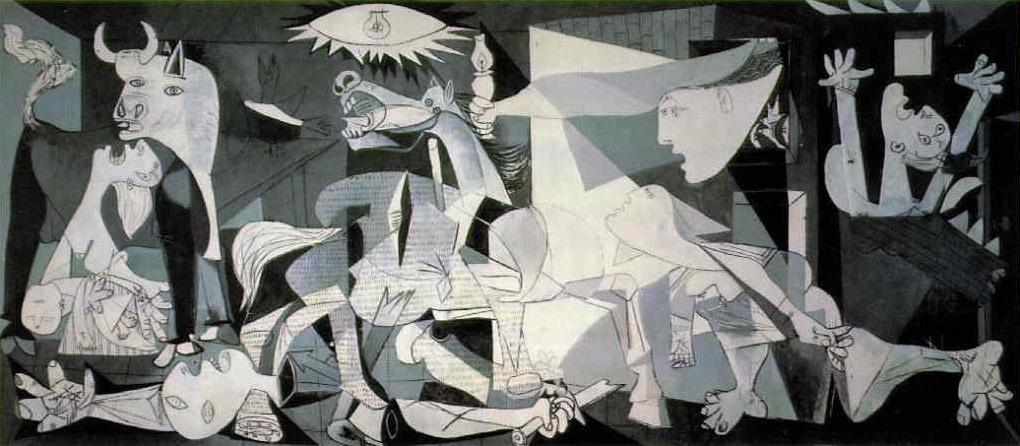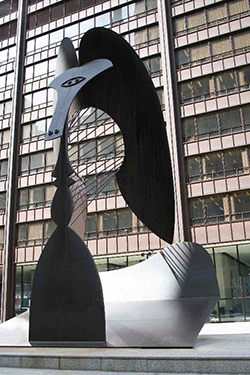 “Guernica” – Pablo Picasso (1937)
“Guernica” – Pablo Picasso (1937)
Source: Philadelphia Museum of Art | Statens Museum for Kunst |
The Art Institute of Chicago | Pablopicasso.org | Wikipedia
Cubism is an early-20th-century avant-garde art movement pioneered by Georges Braque and Pablo Picasso, joined by Jean Metzinger, Albert Gleizes, Robert Delaunay, Henri Le Fauconnier, František Kupka, Fernand Léger and Juan Gris that revolutionized European painting and sculpture, and inspired related movements in music, literature and architecture. Cubism has been considered the most influential art movement of the 20th century.
A primary influence that led to Cubism was the representation of three-dimensional form in the late works of Paul Cézanne, which were displayed in a retrospective at the 1907 Salon d’Automne. In Cubist artwork, objects are analyzed, broken up and reassembled in an abstracted form—instead of depicting objects from one viewpoint, the artist depicts the subject from a multitude of viewpoints to represent the subject in a greater context.
Cubist Sculpture

Just as in painting, Cubist sculpture is rooted in Paul Cézanne’s reduction of painted objects into component planes and geometric solids (cubes, spheres, cylinders, and cones). And just as in painting, it became a pervasive influence and contributed fundamentally to Constructivism and Futurism.
Cubist sculpture developed in parallel to Cubist painting. During the autumn of 1909 Picasso sculpted Head of a Woman (Fernande) with positive features depicted by negative space and vice versa. According to Douglas Cooper: “The first true Cubist sculpture was Picasso’s impressive Woman’s Head, modeled in 1909-10, a counterpart in three dimensions to many similar analytical and faceted heads in his paintings at the time.” These positive/negative reversals were ambitiously exploited by Alexander Archipenko in 1912–13, for example in Woman Walking. Joseph Csaky, after Archipenko, was the first sculptor in Paris to join the Cubists, with whom he exhibited from 1911 onwards. They were followed by Raymond Duchamp-Villon and then in 1914 by Jacques Lipchitz, Henri Laurens and Ossip Zadkine.
Pablo Picasso (1881–1973) was a Spanish painter, sculptor, printmaker, ceramicist, stage designer, poet and playwright who spent most of his adult life in France. As one of the greatest and most influential artists of the 20th century, he is known for co-founding the Cubist movement, the invention of constructed sculpture, the co-invention of collage, and for the wide variety of styles that he helped develop and explore. Among his most famous works are the proto-Cubist Les Demoiselles d’Avignon (1907), and Guernica (1937), a portrayal of the German bombing of Guernica during the Spanish Civil War.
Picasso, Henri Matisse and Marcel Duchamp are regarded as the three artists who most defined the revolutionary developments in the plastic arts in the opening decades of the 20th century, responsible for significant developments in painting, sculpture, printmaking and ceramics.
Picasso demonstrated extraordinary artistic talent in his early years, painting in a realistic manner through his childhood and adolescence. During the first decade of the 20th century, his style changed as he experimented with different theories, techniques, and ideas. His work is often categorized into periods. While the names of many of his later periods are debated, the most commonly accepted periods in his work are the Blue Period (1901–1904), the Rose Period (1904–1906), the African-influenced Period (1907–1909), Analytic Cubism (1909–1912), and Synthetic Cubism (1912–1919).
Exceptionally prolific throughout the course of his long life, Picasso achieved universal renown and immense fortune for his revolutionary artistic accomplishments, and became one of the best-known figures in 20th-century art.






